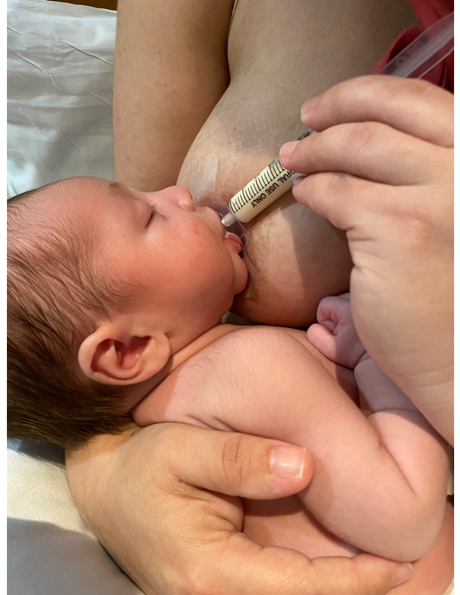Alternative Feeding Methods
Jan 30, 2023
There are times when newborns struggle to latch, or families face other challenges which cause an interruption to breastfeeding in the early days. When this happens, supplemental feedings often become necessary. The question is, what is the best way to deliver that supplement so as not to break the baby and not to break the mother in terms of breastfeeding success.
Why not just use a bottle and nipple?
Here's why: “The physiology of suckling at the breast is different from the physiology of suckling from a feeding bottle and an artificial nipple. It is possible that the use of the feeding bottle and an artificial nipple could lead to breastfeeding difficulties, particularly if use is prolonged.” (1)
What can be used if not an artificial nipple?
The most common alternative feeding methods are:
-
Spoon feeding
-
Finger/Syringe feeding
-
At-breast feeding devices (example: Lact-Aid)
-
Cup feeding
Which of these are best? Well, that depends on a few things.
- What volume of supplement is needed?
- How long with the baby require supplementation?
- What are the family’s breastfeeding goals?
- What is the family most comfortable with?
Here are 4 tips for choosing the best alternate feeding method:
- Spoon / Small supplements of colostrum (< 1 mL) which are needed only temporarily can easily be fed by spoon. Placing a small spoon of colostrum to the baby’s mouth allows them to taste, smell and lap up the milk safely. Sometimes this is all that’s needed to pique the baby’s interest and get him nursing.
- Oral Syringe / Somewhat larger volumes of milk for example 1-15 mL, can be fed by oral syringe feeding. This can be done directly at the breast if baby is able to latch, or by allowing baby to suck on a finger. This is no different than giving a baby a medication or vitamin by syringe or dropper. In my experience, this method is easy to teach to parents and is a good fit for supplementation in the early days of life. It often serves as a “bridge,” until mom’s supply picks up and baby is breastfeeding efficiently. See picture below.
- Cup / If larger volumes of milk are required (15 or more mL), cup feeding is a great choice. Babies take very well to milk offered by cup – lapping it up quite naturally. The biggest problem with cup feeding is a bit of spillage – keep burp cloth handy!
- At Breast Supplementer / For long-term supplementation for families who have long-term breastfeeding challenges, an at-breast supplementer is an ideal option. This can be a great choice for babies who can latch and suckle well at the breast, but require more volume. Baby is fed at breast, mother experiences the joy of direct breastfeeding, and the breasts are well-stimulated.
My least favorite option in the early days is the artificial nipple and bottle. The newborn is hard-wired to “go where the milk is.” Once they find a way to easily and successfully get milk from a bottle, they often will then struggle at the breast. The feeling is different, the suck required is different, and the flow is different. However, sometimes this is the option parents are the most comfortable with. Pacing the feed and using a slow flow nipple are important tips when a bottle is used in the first days.
Like any feeding decision, parents should be given the information, the options, and if requested the recommendation that fits best with their feeding goals. Then it’s up to them to choose what they feel is best, and we support that decision.

References
- Baby-Friendly USA. “Guidelines and Evaluation Criteria for Facilities Seeking Baby-Friendly Designation.” Albany, NY: Baby-Friendly USA, 2016
Subscribe to our Blog
Join our mailing list to receive the latest blog posts, courses and updates from our team.
We hate SPAM. We will never sell your information, for any reason.

